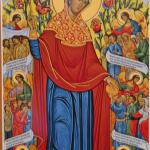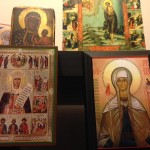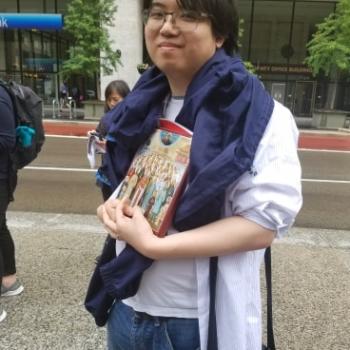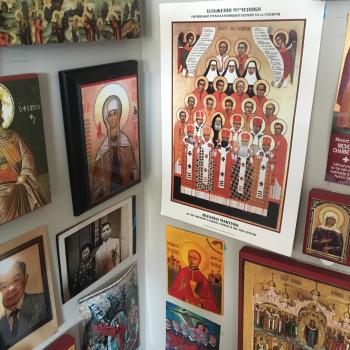![Statue of Berehynia on top of Independence Monument, Kyiv - by Amit just amit, 31 Oct 2015 (Statue_of_Berehynia.jpg) (CC BY-SA 4.0 [https://creativecommons.org/licenses/by-sa/4.0/deed.en]), via Wikimedia Commons](https://wp-media.patheos.com/blogs/sites/721/2017/08/Statue_of_Berehynia.jpg)
I can imagine a number of very concerned responses about the implications of Hayda’s suggestions. The offence does not lie in the fact that the goddess trope is itself pagan; if that were so, this would all be relatively unproblematic, at least in a contemporary theologico-literary imagination, no matter how many references to cutting down Asherah poles there might be in Hebrew Scripture. In what is probably J.R.R. Tolkien’s most important work, ‘On fairy-stories’ – found in the collection Tree and Leaf (which also includes the equally important Leaf by Niggle) – the Catholic godfather of all contemporary fantasy literature insists that the primal structure of the great mythologies often result in eucatastrophe, a good ending, and that because of this, a sort of proto-evangelium can be seen in the truest of pagan stories. Tolkien himself appropriates from Norse mythology to construct the pantheon of the Valar in Middle-earth; the details can be found in The Silmarillion, but even Frodo and Sam’s invocations of Elbereth Gilthoniel in The Lord of the Rings pick up from the primal urge to call on the Divine Feminine, while the place of the supernatural queen Varda they invoke is part of the Valar, which Tolkien insists is under the watchful gaze of the true Creator, Eru Ilúvatar. In this way, Varda’s place as not-quite-goddess-while-appropriated-from-Norse-goddess-mythology mirrors his Catholicism: the Virgin Mary is not a goddess, but she can still be powerfully invoked.
Such an argument is interestingly mirrored in what might be called women-of-color scholarship. The Chicana scholar-activist Gloria Anzaldúa, arguably one of the godmothers of this scholar-activist movement, points out that the Lady of Guadalupe owes her imagery of trampling on the serpent to the Nahuatl word Coatlalopeuh, she who tramples on the serpents; what she is saying is that the whole idea that Guadalupe stands for the conversion of a nation that includes both indigenous and settler colonizers owes itself to a deep local myth that problematizes the very idea of borders.
Hayda, Tolkien, Anzaldúa: much as I’d love for them to all get along, I could imagine that a fight might break out if they were all put into a room. And yet, they agree on how the Theotokos might be treated in the processes of Kyivan, Norse, and Mexican inculturation as a kind of conversion of the goddesses. There is no controversy here: this is less about Mary and more about how people treat her when they encounter her, which is of course quite subjective.
The controversy might lie instead in the dark appropriation of this pagan-turned-Christian inculturation by far-right nationalists. This is, I think, the part about the violence in Charlottesville – as itself a symptom of the emergence of calls for white ethnostates, the rise of an ‘alt-right’ that purports to take western cultural mythologies more seriously than politically conservative elites, and the antisemitic hatred for what is seen as a transnational ‘globalist’ syndicate of market capitalists undermining these myths – that is so difficult to talk about. That white supremacy is bad is easy to understand, but the myths that purport to underwrite the supremacy of whiteness make for uncomfortable conversation: like the Nazis imagining the Third Reich through appropriated Germanic and Hindu occult symbols, the contemporary far-right’s fusion of pagan mythology and Christian symbols bring the appeal to the primal itself into disrepute.
And so, especially in the shadow of Charlottesville, at least I speak of the encounter with the Theotokos as a subjective experience of the conversion of the goddesses with faltering lips and a stuttering tongue. One of the chants, after all, was blood and soil. This is no time to speak of fertility goddesses. No wonder the Revolution of Dignity at Maidan, under the figure of Berehynia, was tainted by the Left with the brush of fascist nationalism. Similarly, my friend Sam Rocha was once accused in print of being a Nazi simply because the word folk in his ‘folk phenomenology,’ with its invocation of primal mythology, sounded etymologically too much of what the Third Reich called the Volk. In a bid for respectable dissociation with such ontological myths, a new ideology is created, centered around the status of mythos itself: you can either divest yourself of them and join the respectably secular real world, or you are no better than those vulgar tiki torch carriers in polo shirts whose death-driven actions culminate in the ramming of a car into a crowd of their projected ‘enemies.’ In fact, much as one would might make fun of the attire and accessories of the Charlottesville protesters, the appropriation of the Polynesian alongside the semi-casual attire of middle-class luxury is precisely what the Asian American historian Gary Okihiro muses about in his books Island World and Pineapple Culture: the Pacific Islands, including the annexed state of Hawai’i and the currently-in-danger-of-nuclear-bomb territory of Guam, are the off-continent peripheries of American empire where many of the objects of desire for Americans are manufactured – their lands stolen, their cultures exoticized, their goddesses turned into pornography. The whitest thing to do, aside from invoking the dark primordial past of pre-conversion Europe, is for polo-shirt sporting white men to cheapen the tiki torch while acting out their masturbatory fantasies in public.
But ideology is not theology, and foreclosing the status of myth simply cedes the ground to the perverse fantasizing of white nationalists. False accounts of the primal are not defeated by shying away from the existential; as Tolkien suggests, their very structure needs to be interrogated and shown to be a lie. The descent to the primal may be a quest for a deeper truth, but some accounts are less true than others. The urge to draw near to the Divine Feminine may have produced the phenomena of goddesses, but it is not in fact true enough to say that there are female divinities. The truth beneath this urge requires an actual encounter with the supernatural, and the force of such interactions often produce conversions, the entry into an ontological depth that shows a previous reality to be so not-true-enough that it is as if the whole world has changed.
There is a mistake, then, in the return to the pagan: while it may certainly be a return from secular technocracy to some kind of primal order, the death drive and the local mythological bonds that hold together an ethnos against all enemies are not quite primordial enough. Conversion is not progress; it is not as if moving away from the pagan is necessarily a form of secularization. Conversion is a revelation of a deeper dimension of the primal: it is that there is resurrection after death, unleashing a force of love that transcend the bonds of kin. The Theotokos is not a goddess; she reveals instead the deeper truth beneath what all the groping for the Divine Feminine was all about.
Hayda’s account of the subjective conversion of Berehynia is not really a return to the pagan in the proper sense, then; it is instead an account of the unique contribution that Kyivans have in our tradition for understanding the drive toward the Divine Feminine and the truest truth of the figure of the Theotokos. Maidan was not an outburst of pagan primordiality; it was a manifestation of the bonds of humanity across the extremest of ideologies against state-sponsored violence, a realization of what Berehynia was really supposed to be about all along: not a goddess, but a pointing to the truth that all of us on this land, completely different from each other as we are in every possible way, are the children of a common mother, the Immovable Wall under whose hands of prayer we are assured that the city will not be taken. Tolkien’s appeal to Norse mythology is not a cheap story of Western supermacy; if anything, it is that the children of Middle-earth, in their diversity of races of elves, men, dwarves, and hobbits, must come together in fellowship to defeat the darkness of uniformity emanating from Mordor. The power of Guadalupe does not lie in nationalist bonds, no matter how many different versions of nationalism for which she has been used; in her, the colonized are exalted and the colonized humbled as they find themselves struggling to co-exist in a common land at their worst when oppression persists and at their best when they realize that they are made to be more.
The truest truth beneath even the most perverse attempts to manipulate the primal for ideological ends is, at the end, an objective one, a moral truth: the earth is constituted by love, created as it is by the G-d who is love, infused with his grace as displayed in the body of the Most Holy Theotokos. The answer to the perversion of the primordial is not to reject it; it is to revisit the moment when the pagan became converted to the life of Christ, when earth and seas on which local divinities were thought to make their erotic whims manifest were baptized into the dance of the Trinity, when goddesses of fertility are displaced by the protecting mantle of Wisdom herself.
Wisdom! the deacon intones to begin the dismissal in the panakhyda, the memorial service where the primal tragedy of death is fully revisited alongside with the even more primordial truth of the resurrection. The response: More honourable than the cherubim, and by far more glorious than the seraphim; ever a virgin, you bore the Word of G-d – true Theotokos, we magnify you!












